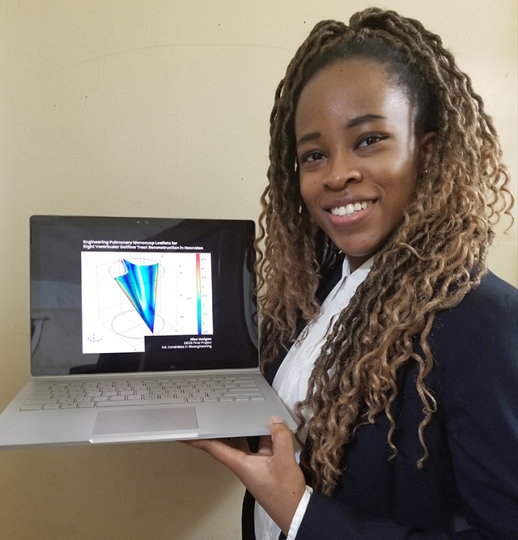Engineering Design Projects (ES 100), the capstone course at the Harvard John A. Paulson School of Engineering and Applied Sciences, challenges seniors to engineer a creative solution to a real-world problem.
Engineering Pulmonary Monocusp Leaflets for Right Ventricular Outflow Tract Reconstruction in Neonates
Nina Uzoigwe, S.B. ‘21, bioengineering
Please give a brief summary of your project.
Alongside a team of bioengineers and a pediatric cardiac surgeon at Boston Children’s Hospital, I geometrically optimized monocusp leaflets that can withstand patient vascular growth and be used in corrective surgeries for neonatal congenital heart defects. More specifically, it can be used for neonates who are suffering from the side effects of Tetralogy of Fallot (TOF) repair. TOF is a birth defect that affects normal blood flow through the heart. A diminutive right ventricular outflow tract is a common feature of TOF as well as other congenital heart anomalies. Current treatments have been shown to lead to pulmonary regurgitation, worsening the quality of life for neonates as they deal with cardiac-associated complications. This design, optimized through COMSOL Multiphysics, addresses this problem by providing a bioengineering solution that would improve hemodynamic stability as blood travels to the lungs for re-oxygenation during child growth.
What was the inspiration for this project?
TOF is the most common cyanotic congenital heart defect and occurs in three to five of every 10,000 live births, accounting for nearly 7 to 10 percent of congenital defects. Within the U.S. alone, about one in every 2,518 babies born each year have this critical condition. Symptoms include cyanosis, fatigue, heart murmurs, poor blood circulation, rapid breathing, and delayed development, necessitating rapid surgical intervention due to its severity. Patients who do not undergo any surgical intervention for TOF have greater than a 75 percent mortality at 10 years of age. Despite the high stakes of neonatal cardiac surgery, there has also been surprising little effort at designing the optimal monocusp valve for a patient of a given size—i.e., the design that will remain competent as long as possible as the child grows. There is thus a great clinical need to geometrically design an artificial monocusp leaflet that is biocompatible, can structurally improve blood circulation to the patient’s lungs during development, and better clinical outcomes resulting from reconstructive cardiac operations.
How will this project help solve the problem you identified?
Through iterative modeling, this novel work presents the first geometrically optimized pulmonary monocusp leaflet for pre-clinical testing that would be able to withstand wider vessel diameters that result from patient growth. Moreover, this workflow and its strategies can serve as a blueprint to cater other valve reconstruction leaflets and improve patient outcomes for patients with irregular valve geometries which predispose them to suboptimal operative procedures.
What were the biggest challenges of this project?
The greatest challenge of this project was virtual thesising in itself, but the strength and support of the ES 100 community helped make this feat all the more achievable, especially during a global pandemic.
What did you learn through this experience?
As an engineer by training, I have learned a great deal about being at the forefront of integrating clinical and medical expertise in engineering solutions. The intersection in the backgrounds of my project advisors significantly enhanced the way I approached my designs. Instructors of surgery at Boston Children's Hospital, Dr. Peter Hammer is a scientist who mathematically models cardiac biomechanics and electrophysiology, and Dr. David Hoganson is a pediatric cardiac surgeon. The input they provided truly allowed me to see and tackle this issue from an engineering and clinical standpoint, dynamically merging both perspectives in this problem space.
Press Contact
Adam Zewe | 617-496-5878 | azewe@seas.harvard.edu
